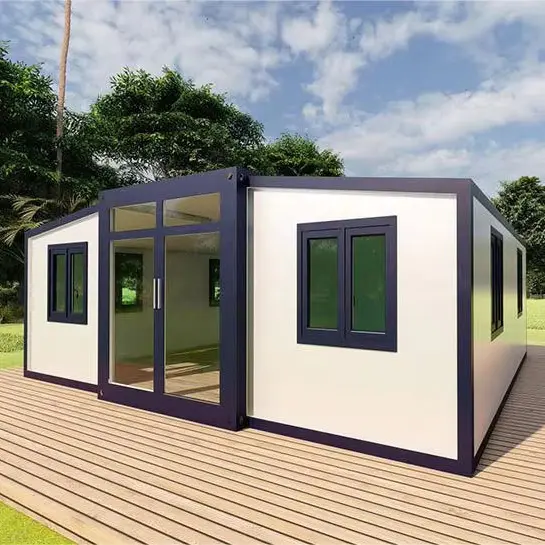Why Is The Expandable Container House Becoming A Popular Trend?
As the world pursues sustainable and creative office work, the Expandable Container House is reshaping the definition of workspace in a subversive manner. Unlike the cold cubicles of traditional offices, this modular building transformed from shipping containers seamlessly integrates large areas of floor-to-ceiling glass with natural landscapes to create a new office paradigm that can inspire creativity and be eco-friendly.

The Expandable Container House uses a unique glass curtain wall to reconstruct the boundaries of space. Panoramic and transparent vision: The entire floor-to-ceiling glass wall blurs the boundaries between indoors and outdoors, allowing workers to bathe in the sun while typing on the keyboard and overlook the mountains or shaded trees. This "transparent office" concept has been proven to increase work efficiency by 37% (Harvard Business School research data).
Suspended structure design: The elevated pillars lift the box off the ground, which not only solves the moisture-proof problem, but also preserves the ecological integrity of the original surface. The lawn below can even be transformed into an open-air meeting area.
Flat-top multifunctional expansion: The flat-top design reserves a location for solar panel installation. In some cases, the roof is converted into a micro garden to form a vertical ecological circulation system.
From fixed office to mobile creative factory. Geographic flexibility: Modular design supports rapid disassembly and assembly, suitable for project-based teams to move with the project. A certain architectural firm even deployed Expandable Container House to a wilderness construction site to achieve "zero-distance design".
Functional complexity: Intelligent dimming blinds are embedded in the glass curtain wall to maximize natural lighting during the day and switch to projection screens at night, turning it into a brainstorming center in seconds.
Cost revolution: Compared with traditional buildings, Expandable Container House can save more than 60% of construction costs, which is particularly suitable for start-ups and freelancers.
Ecological revolution in the glass box
Photovoltaic curtain wall integration: embed power-generating glass into the curtain wall system, and the annual power generation can meet 70% of office needs.
Climate responsive design: natural ventilation is achieved through the retractable glass dome, and the ground source heat pump system is used to create a zero-carbon circulation space.
Metaverse interface: Microsoft and other technology giants are already testing AR glass curtain walls, and workers can obtain real-time data through visual overlays to truly achieve "transparent decision-making".
Expandable Container House wraps the softest humanistic care with an industrial shell - when the sun penetrates the glass curtain wall and casts geometric light and shadow on the desktop, and when the raindrops hit the metal shell, it plays white noise. This contradictory aesthetic of "roughness and refinement" hits the core demands of people for workspace in the post-epidemic era: both efficient output and poetic living. True creativity is often born at the intersection of rules and freedom, and the container studio is the perfect intersection.





